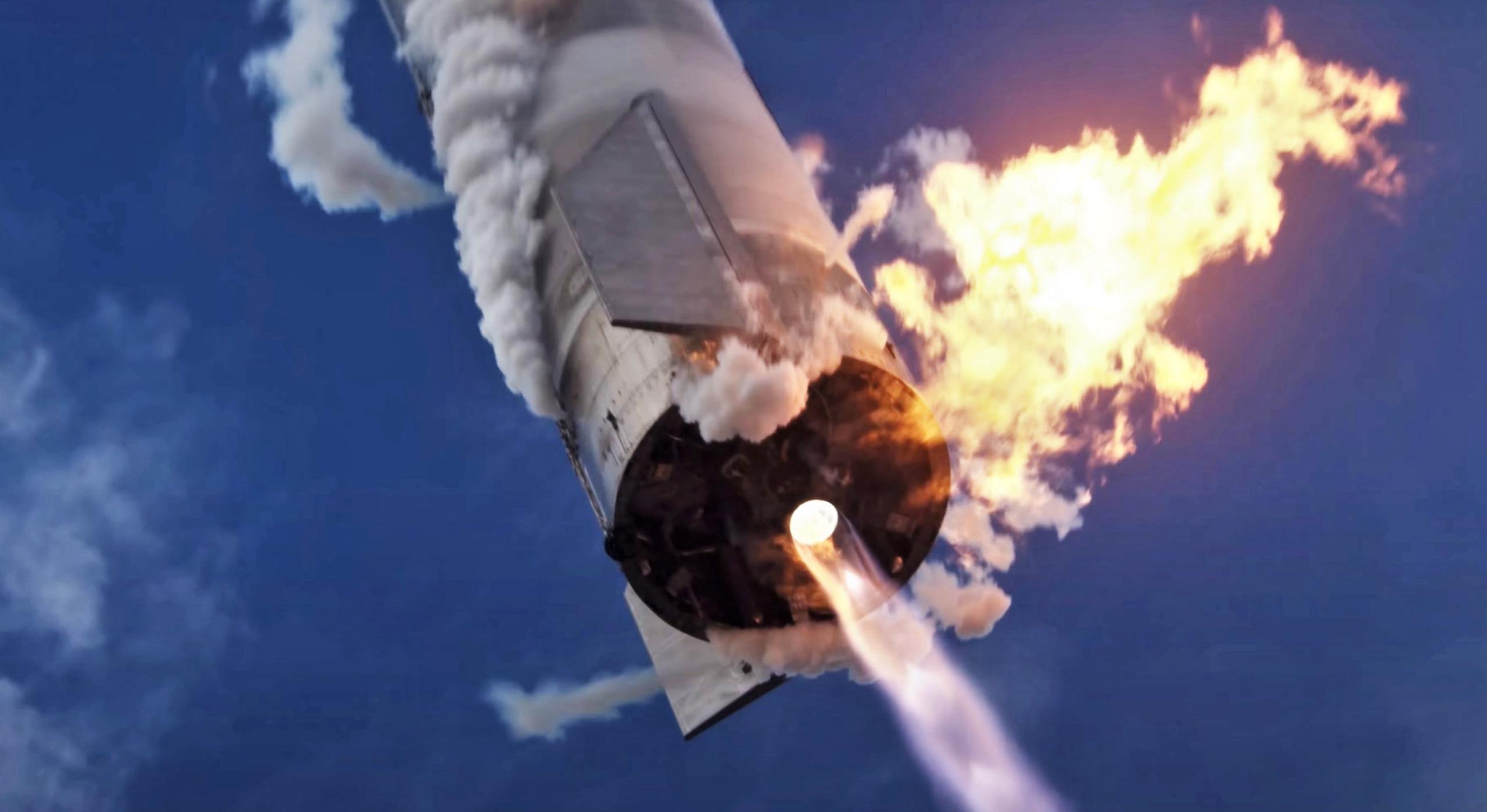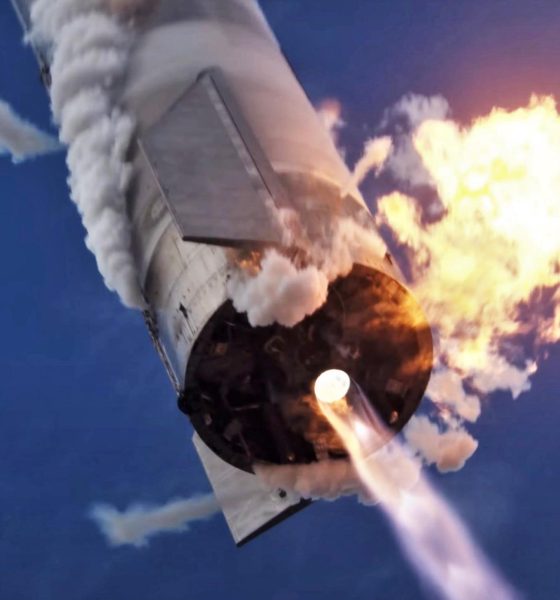

News
SpaceX recaps historic Starship landing in 4K as next ship readies for flight
SpaceX has published a new 4K video recapping Starship’s first intact landing after a high-altitude launch right as the company is preparing the next ship for flight.
On March 3rd, Starship serial number 10 (SN10) briefly became the first prototype to successfully launch to 10 km (6.2 mi), ‘skydive’ back to Earth, flip around, and land in one piece. Put simply, Starship SN10 made it unequivocally clear that the exotic, unproven method of landing selected by SpaceX could be made to work. Unfortunately, while Starship SN10 did land in one piece, the landing was much harder than planned.
Due to some combination of that hard landing and an apparent onboard fire that started in the last ~20 seconds of flight, SpaceX only had around six minutes to contemplate its success before Starship SN10’s propellant tanks were breached, violently depressurizing the rocket and causing a large explosion and fire.
Previously discussed on Teslarati, SpaceX CEO Elon Musk later took to Twitter to offer some educated guesses as to why Starship SN10 exploded.
“Starship SN9 ultimately failed a few seconds earlier than Starship SN8 when one of its Raptor engines failed to ignite, precluding a true flight test of the helium pressurization fix. As it turns out, Musk believes that that very fix may have doomed Starship SN10.
As Starship SN10 forged ahead past the points of failure that killed SN8 and SN9, the SpaceX CEO thinks that one or more of the vehicle’s three Raptor engines began to ingest some of that helium as they drained the methane header tank. As a result, engine thrust fell below expected values, preventing Starship SN10 from fully slowing down for a soft landing. Instead, the Starship hit the ground traveling a solid 25 mph (~10 m/s), obliterating its tiny landing legs and damaging its skirt section.”
Teslarati.com – March 10th, 2021
In other words, the losses of Starships SN8, SN9, and SN10 all share a relatively common point of failure – propulsion reliability. Technically, only Starship SN9’s failure can be blamed specifically on Raptor, one of which failed to ignite during its flip and landing maneuver. SN8 and SN10 both failed because of issues in the complex network of plumbing and pressurization systems responsible for feeding Raptors the right amount of propellant.
For SN8, the ship’s pressurization system failed to provide the necessary fuel head pressure at the last second, starving the Starship’s Raptors. SN10 ironically failed because the quick fix inspired by SN8’s failure – partially replacing a methane pressurant with helium – likely contaminated its methane fuel with helium, effectively watering down Raptor’s performance. While likely frustrating for SpaceX, the failures are still extremely valuable and loss of hardware remains a routine and intentional part of the company’s approach to iterative rocket development.
On the plus side, the FAA has already cleared SpaceX’s next Starship for flight after SN10’s momentary success and subsequent explosion. Spurred by that brief taste of total success, SpaceX wasted no time to prepare that next prototype – Starship SN11 – for flight and rolled the rocket to the launch pad mere days after SN10’s March 3rd flight. That very same day, SpaceX completed ambient pressure testing – a basic verification that Starship SN11 is leak-free.
A few days later, SN11 appeared to pass its first cryogenic proof test, replacing room-temperature gas with cryogenic liquid nitrogen. Three days after that, SpaceX attempted to put the Starship through its first triple-Raptor static fire test but appeared to suffer an abort milliseconds after a partial ignition of one or two of its three engines. Starship SN11 briefly caught fire and burned for at least 20-40 seconds after the abort, unsurprisingly triggering several days of delays. Nevertheless, if SN11 can make it through a second static fire attempt without issue on Thursday or Friday, the Starship is still well on track to take flight weeks earlier than any of its predecessors.

News
Elon Musk’s Grokipedia surges to 5.6M articles, almost 79% of English Wikipedia
The explosive growth marks a major milestone for the AI-powered online encyclopedia, which was launched by Elon Musk’s xAI just months ago.

Elon Musk’s Grokipedia has grown to an impressive 5,615,201 articles as of today, closing in on 79% of the English Wikipedia’s current total of 7,119,376 articles.
The explosive growth marks a major milestone for the AI-powered online encyclopedia, which was launched by Elon Musk’s xAI just months ago. Needless to say, it would only be a matter of time before Grokipedia exceeds English Wikipedia in sheer volume.
Grokipedia’s rapid growth
xAI’s vision for Grokipedia emphasizes neutrality, while Grok’s reasoning capabilities allow for fast drafting and fact-checking. When Elon Musk announced the initiative in late September 2025, he noted that Grokipedia would be an improvement to Wikipedia because it would be designed to avoid bias.
At the time, Musk noted that Grokipedia “is a necessary step towards the xAI goal of understanding the Universe.”
Grokipedia was launched in late October, and while xAI was careful to list it only as Version 0.1 at the time, the online encyclopedia immediately earned praise. Wikipedia co-founder Larry Sanger highlighted the project’s innovative approach, noting how it leverages AI to fill knowledge gaps and enable rapid updates. Netizens also observed how Grokipedia tends to present articles in a more objective manner compared to Wikipedia, which is edited by humans.
Elon Musk’s ambitious plans
With 5,615,201 total articles, Grokipedia has now grown to almost 79% of English Wikipedia’s article base. This is incredibly quick, though Grokipedia remains text-only for now. xAI, for its part, has now updated the online encyclopedia’s iteration to v0.2.
Elon Musk has shared bold ideas for Grokipedia, including sending a record of the entire knowledge base to space as part of xAI’s mission to preserve and expand human understanding. At some point, Musk stated that Grokipedia will be renamed to Encyclopedia Galactica, and it will be sent to the cosmos.
“When Grokipedia is good enough (long way to go), we will change the name to Encyclopedia Galactica. It will be an open source distillation of all knowledge, including audio, images and video. Join xAI to help build the sci-fi version of the Library of Alexandria!” Musk wrote, adding in a later post that “Copies will be etched in stone and sent to the Moon, Mars and beyond. This time, it will not be lost.”
News
Tesla Model 3 becomes Netherlands’ best-selling used EV in 2025
More than one in ten second-hand electric cars sold in the country last year was a Tesla Model 3.

The Tesla Model 3 became the most popular used electric car in the Netherlands in 2025, cementing its dominance well beyond the country’s new-car market.
After years at the top of Dutch EV sales charts, the Model 3 now leads the country’s second-hand EV market by a wide margin, as record used-car purchases pushed electric vehicles further into the mainstream.
Model 3 takes a commanding lead
The Netherlands recorded more than 2.1 million used car sales last year, the highest level on record. Of those, roughly 4.8%, or about 102,000 vehicles, were electric. Within that growing segment, the Tesla Model 3 stood far ahead of its competitors.
In 2025 alone, 11,338 used Model 3s changed hands, giving the car an 11.1% share of the country’s entire used EV market. That means more than one in ten second-hand electric cars sold in the country last year was a Tesla Model 3, Auto Week Netherlands reported. The scale of its lead is striking: the gap between the Model 3 and the second-place finisher, the Volkswagen ID3, is more than 6,700 vehicles.
Rivals trail as residual values shape rankings
The Volkswagen ID.3 ranked a distant second, with 4,595 used units sold and a 4.5% market share. Close behind was the Audi e-tron, which placed third with 4,236 registrations. As noted by Auto Week Netherlands, relatively low residual values likely boosted the e-tron’s appeal in the used market, despite its higher original price.
Other strong performers included the Kia Niro, the Tesla Model Y, and the Hyundai Kona, highlighting continued demand for compact and midsize electric vehicles with proven range and reliability. No other model, however, came close to matching the Model 3’s scale or market presence.
News
Tesla Model Y Standard Long Range RWD launches in Europe
The update was announced by Tesla Europe & Middle East in a post on its official social media account on X.

Tesla has expanded the Model Y lineup in Europe with the introduction of the Standard Long Range RWD variant, which offers an impressive 657 km of WLTP range.
The update was announced by Tesla Europe & Middle East in a post on its official social media account on X.
Model Y Standard Long Range RWD Details
Tesla Europe & Middle East highlighted some of the Model Y Standard Long Range RWD’s most notable specs, from its 657 km of WLTP range to its 2,118 liters of cargo volume. More importantly, Tesla also noted that the newly released variant only consumes 12.7 kWh per 100 km, making it the most efficient Model Y to date.
The Model Y Standard provides a lower entry point for consumers who wish to enter the Tesla ecosystem at the lowest possible price. While the Model 3 Standard is still more affordable, some consumers might prefer the Model Y Standard due to its larger size and crossover form factor. The fact that the Model Y Standard is equipped with Tesla’s AI4 computer also makes it ready for FSD’s eventual rollout to the region.
Top Gear’s Model Y Standard review
Top Gear‘s recent review of the Tesla Model Y Standard highlighted some of the vehicle’s most notable features, such as its impressive real-world range, stellar infotainment system, and spacious interior. As per the publication, the Model Y Standard still retains a lot of what makes Tesla’s vehicles well-rounded, even if it’s been equipped with a simplified interior.
Top Gear compared the Model Y Standard to its rivals in the same segment. “The introduction of the Standard trim brings the Model Y in line with the entry price of most of its closest competition. In fact, it’s actually cheaper than a Peugeot e-3008 and costs £5k less than an entry-level Audi Q4 e-tron. It also makes the Ford Mustang Mach-E look a little short with its higher entry price and worse range,” the publication wrote.








